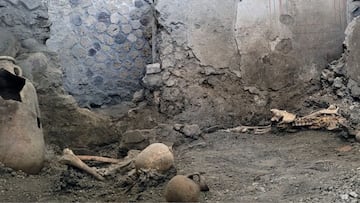Unusual find in Pompeii sheds new light on Vesuvius eruption
Two new bodies were discovered in the House of Lovers in Pompeii buried long ago during the eruption of Mount Vesuvius giving new insights to the tragedy.

The skeletons of two Pompeii inhabitants have came to light after new excavations in the archaeological area of the city destroyed by the Vesuvius volcano almost two thousand years ago. Although the death toll from that catastrophe is unknown, between 16,000 and 20,000 people lived in the area.
This new discovery provides more precise details of the moments the eruption happened, because the inhabitants of Pompeii were not only killed by the lapilli, or small fragments of lava, the ash and the hot gases released by Vesuvius, but also by landslides from a major earthquake connected with the eruption.
Where was the couple found?
“Part of the south wall of the room collapsed, crushing one of the men whose raised arm offers a tragic image of his vain attempt to protect himself from the falling masonry. The conditions of the west wall demonstrate the tremendous force of the earthquakes that occurred at the same time as the eruption: the entire upper part detached and fell into the room, crushing and burying the other individual,” revealed the archaeologists who publicly exhibited the finding.
The couple, who were at least 55 years old, were found during the excavations of the House of Lovers undergoing work to improve the safety of the building, more specifically in a utility room where both had sought refuge and died from multiple traumas when parts of the building collapsed.
Two skeletons have been found in the ruins of Pompeii, the ancient Roman city wiped out by an eruption of volcano Mount Vesuvius nearly 2,000 years ago https://t.co/jqo1SLCouo pic.twitter.com/t9n1XIfhWZ
— Reuters (@Reuters) May 17, 2023
The rest of the material discovered during the extraction
In an adjoining room, investigators found a stone kitchen counter covered in powdered lime, indicating that construction work was taking place nearby at the time of the eruption, according to several experts.
As if this were not enough, during the extraction of the cervical vertebrae and the skull of one of the two skeletons, remains of organic material emerged, probably a piece of cloth, in addition to five elements of glass paste identifiable as beads from a necklace and six coins.
The impact of the finding
Undoubtedly, this finding provides evidence increasingly clear that, during the eruption, landslides associated with the accumulation of lapilli or the impact of pyroplastic flows were not the only danger to the lives of the inhabitants of ancient Pompeii.
For the director of the archaeological area, Gabriel Zuchtriegel,“ modern excavation techniques help us better understand the hell that completely destroyed the city of Pompeii in two days, killing many inhabitants: children, women and men. With analysis and methodologies we can get closer to the last moments of his life.”
What happened in Pompeii?
Related stories
In 79 AD, the ancient Roman city of Pompeii was devastated by a series of powerful earthquakes that preceded the catastrophic eruption of the volcano Vesuvius. This volcanic eruption completely engulfed the city and its population, amazingly preserving it for centuries and allowing contemporary archaeologists and scholars to reconstruct and fully understand life in ancient Rome.
With all this, it should be noted that Pompeii, for researchers, is an immense archaeological laboratory that has regained strength in recent years, “astonishing the world” with the constant discoveries revealed and demonstrating the Italian excellence in this sector.


